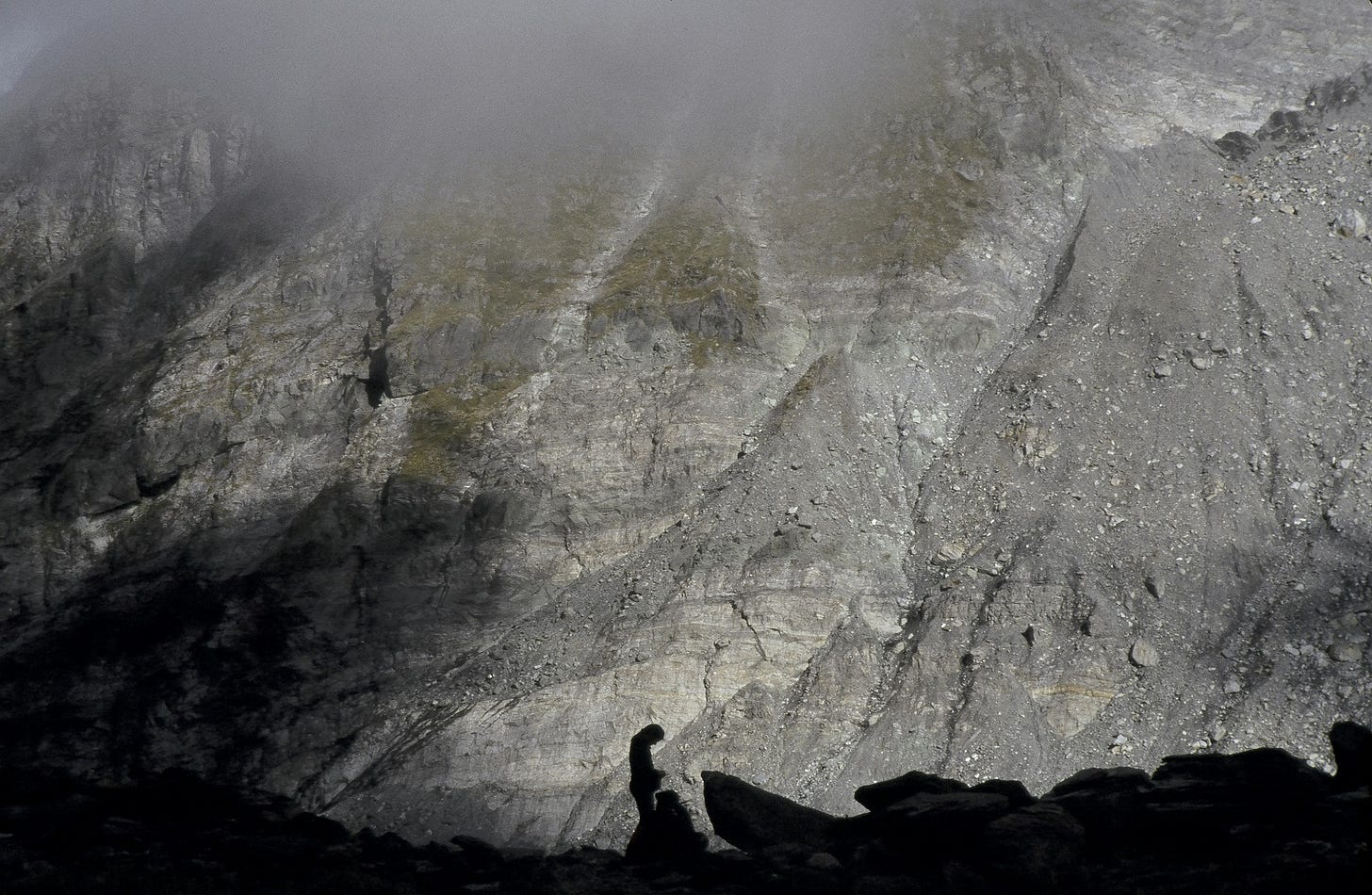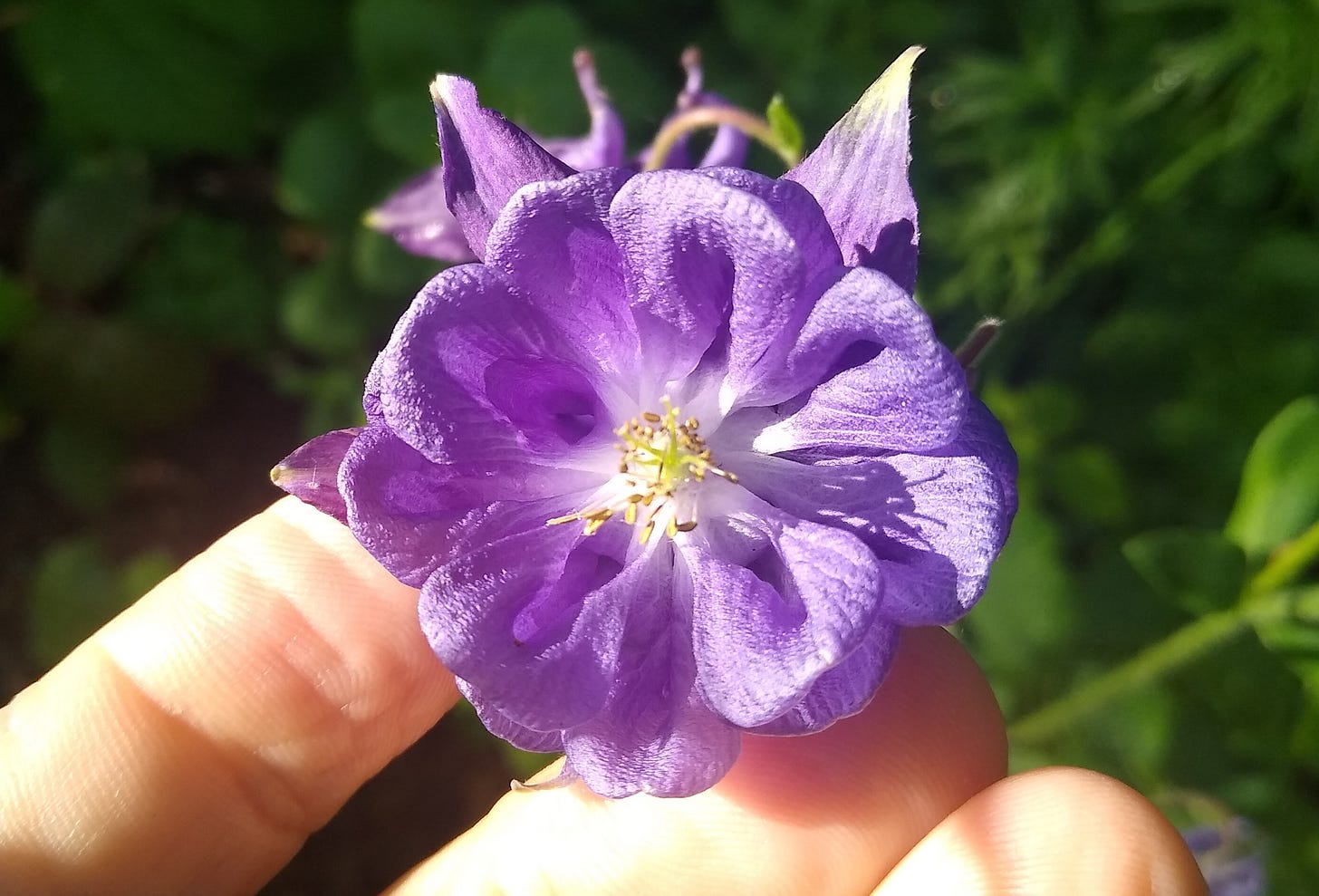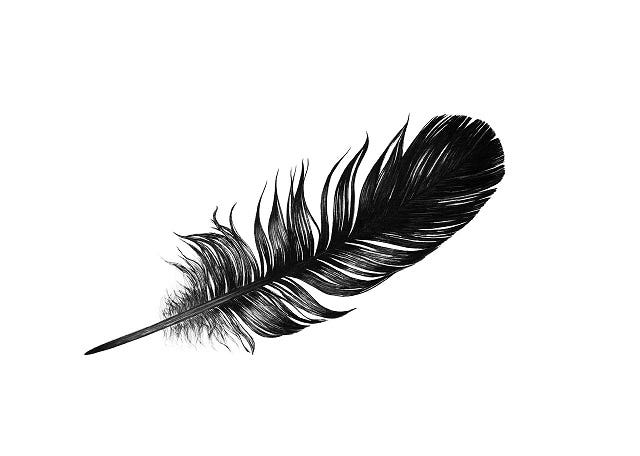The Wake-Up Call
7/17/25 – The importance of awe in everyday life
Hello everyone:
Normally, I would write this plea here: “please remember to scroll past the end of the essay to read some curated Anthropocene news.” But we’re away, and you’re free to move on to other things after (I assume) reading this week’s piece on awe. I have, however, left you an important message in place of this week’s Anthropocene news. Read and heed, please.
Now on to this week’s writing:
Sadly, not everyone has a river for a neighbor, but everyone is familiar with a river as a metaphor for the passage of time. We feel the movement of time from one instant to the next, from one experience to the next, but every moment has its own fluid texture: faster, slower, rougher, smoother, aimed straight for the horizon or disappearing around the bend… Sometimes, time dilates and we’re paused in an eddy, either feeling panicked and stuck in crisis or joyfully lost in the moment.
We observe this changing texture over moments, hours, days, years, and decades, and we call it life. What we call memory is a history of the river. This all sounds philosophical, but I mean it literally. Try this: Run your mind back over recent hours and map out the different textures of the moments in which you yawned, were annoyed by your neighbor’s car alarm, delighted in a cardinal at the feeder, coughed up smoke from Canadian wildfires, remembered a lost loved one, suddenly remembered the stove is on, saw the sun breaking through the clouds, grimaced at the news from D.C., and began reading these opening paragraphs. Our perception of time flows erratically over the different textures of experience.
I want to ask, though, when you picture this river, are you floating down it or (like Hesse’s Siddhartha) perched on the bank observing its passage? Either way is fine. It’s a metaphor, and you can inhabit it anyway you like.
But let’s get rid of the metaphor. Where does that leave us? Time, without its metaphor, is felt as some mysterious compelling force that accompanies us between birth and death. After that, who knows? Here among the living, we perceive it as a measure of experience, but that might just be our peculiar consciousness giving meaning to the changes all around us, changes in the rocks and clouds and light, and changes in the behavior of cells in our bodies and in the bodies of our fellow species. We give transformation a narrative when it might only be the universe breathing.
The physical world, too – the “space” in space and time and the “where” in Where are we? – is some vibrating plane of reality that seems to be traveling down the same river but is more likely merely changing shape, like a flickering fire. Matter is neither being made nor destroyed. Everything is energy. The Sun, the sunlit butterfly, and the shadowed walls of the Grand Canyon are made of the same stuff. So are you, and so are the eyes and mind with which you’re watching it all happen.
Together, space and time make up a fabric into which our existence is woven. That’s our best guess, at least. Honestly, though, science can only account for about 5% of all matter in the universe. What we call “dark matter” (~25%) and “dark energy” (~70%) are the placeholder names we use to guess at the footsteps we hear approaching from all around us in the dark forest. Whatever the truth may be, it’s a safe bet that the other 95% of the universe will redefine what we call life and its context.
Here on Earth, then, we live in mystery. The awareness of that mystery is what we call awe.
Or we can call it wonder, or being overwhelmed, or feeling a quiet joy. We could even call it ignorance, though that word has become an insult in a world that confuses information for wisdom and that insists modern humans know exactly what they’re doing. We don’t, which is why in this era of too many people doing far too much for too little reason, letting down our guard and smiling at the mystery is really, really good for us. In fact, it’s what we evolved to do.
It's hard to talk about the necessity of awe without sounding precious. But that’s my task here. And it shouldn’t be too hard, because on some level we already know that a steady diet of awe is as necessary to our well-being as food and water. Without it, life is a windowless room in which meaning can only be constructed rather than found. We know we need more than that.
Awe is a clear lens through which we see the real world as it is: astonishing, strange, dangerous, beautiful, and equally vast and intricate beyond measure. Many of you may call that clear lens God, but neither spirituality nor religion are required. We only need to pay attention to whatever is beyond the self.
When was the last time you felt the world fall away as you experienced, for a moment, a sense of wonder or awe? Hopefully, it was yesterday, or earlier today. If not, why not?
Because awe is merely awareness, not some heightened state that you have to work to achieve. The work to experience awe, if we want to call it work, is only to quiet the chatter and strip away the clutter long enough to merely open our eyes (and other senses) to perceive some fragment of the vast mystery.
I’ve opened this essay with an attempted sketch of the whole mystery, but our experience of it is by necessity only of fragments, each one beautiful, strange, and powerful. The daisy and the bee, the cloud and the sky, the radish and the garden, the birth and the child, or the death and the parent. We live in relation to awe in all of our relationships, familial and ecological. It’s there, if we allow ourselves to feel it as those relationships deepen in meaning.
A child asked Walt Whitman about a fragment, and his answer underpins one of the world’s great books of poetry:
A child said What is the grass? fetching it to me with full hands; How could I answer the child? I do not know what it is any more than he. I guess it must be the flag of my disposition, out of hopeful green stuff woven. Or I guess it is the handkerchief of the Lord, A scented gift and remembrancer designedly dropt, Bearing the owner's name someway in the corners, that we may see and remark, and say Whose?
I was inspired to write about awe because of a long-form exploration of the importance of awe in Noema magazine. Among the many things to learn in the piece, there’s this: When we feel awe, we become happier, less self-involved, more kind, more connected to others and the natural world, and healthier.
One researcher has found that the regular experience of awe is an excellent predictor of low levels of inflammation. She said in a subsequent TED talk that
I used to see a walk in nature or a trip to the museum as a luxury I could rarely afford in my busy life. Now I see these experiences as essential to my mental and physical health.
The Noema piece is built around a profile of Dacher Keltner, head of the Greater Good Science Center (GGSC) at UC Berkeley and the author of the book, Awe: The New Science of Everyday Wonder and How It Can Transform Your Life. (Keltner was also a consultant for Pixar’s hit animated movie, Inside Out.) One of his more interesting studies involved two groups of students, one of which was asked to gaze into a eucalyptus grove for one minute. The other group was asked to stare at a nearby building. A questionnaire for both groups immediately afterward suggested that the eucalyptus-gazers were significantly less egocentric:
Upon being asked to imagine how much they should be paid for their participation in the study, they asked for significantly less money. Finally, in response to a staged accident in which the experimenter dropped some pens, the eucalyptus group was observed to react more helpfully. A short burst of awe seemed to leave participants feeling more altruistic, more collaborative and less entitled.
Keltner emphasizes that awe is often a social phenomenon. We are a deeply social species, and to see that you don’t have to look farther than the political and ecological cliffs we’re willing to jump off if everyone else is doing it too. Awe can be the path to ruin, if we’re in thrall to the wrong magic. On the bright side, you can feel awe in action in those beautiful moments when we sing or pray together, or when we witness human achievement as a crowd. We are “swept up” and “carried away,” as if caught in the river together.
Moreover, Keltner suggests that our physiological reactions to awe (e.g. goosebumps, tears) are social signals that draw us together. I’ve certainly noticed that we become open-hearted when reminded of the magic of existence. It’s harder to maintain resentment while watching a meteor shower. And we all know intuitively that we can reduce or reset our social anxieties by taking a walk and experiencing a bit of awe.
Awe doesn’t need to be intense or dramatic. I doubt the undergrads were awestruck by the eucalypts, or even concluded their minute by saying, “Awesome!”, that most abused of sacred words. So, how does Keltner define awe? The Noema article is a bit fuzzy on his thesis, but I think the two main concepts, “perceived vastness” and “the need for accommodation,” come down to this: We feel astonished or overwhelmed by what we’re witness to, and have to broaden our mind to take it in.
Staring at the branches of a eucalyptus grove for one minute, however, is not about experiencing something earth-shaking or mind-boggling, so really what we’re talking about is feeling a connection to something greater, however we define it. We can feel awe when falling in love, imagining the cosmos, witnessing powerful art, hiking on mountaintops above the clouds, feeling fear in a thunderstorm, singing in a choir, taking psychedelics, strolling in a forest, studying with a magnifying glass or microscope the intricacies of an insect or blossom, or any one of a million ways we might connect with existential realities outside our self. The magic can be small and quiet, and often is.
Like the dawn chorus of birds outside our windows, awe is a wake-up call. If we’re listening, we can hear it every day.
Talking about awe this way blurs the definition enough that we might as well be talking about wonder or meditative curiosity. There’s a diversity of awe that ranges from sacred to satisfying. And that’s fine for me. Categories and definitions aren’t the point here. Awe is about the value of experiences that take us out of ourselves and into the fabric of existence. We have to step out of the self to cultivate it.
So, the possibility of awe is all around us, and the more we make it a daily habit the happier and healthier we’ll be. For my purposes here in the Field Guide, I’ll note also the importance of Earthlings using their capacity for awe to motivate the necessary transformation of society. Arguably, the lack of active awe for the natural world in our disconnected and distracted daily life underpins much of the catastrophe that’s unfolding.
But it’s less our fault than the fault of those who’ve built the junk-food quality aspects of civilization, giving us occasional fireworks while blotting out the depths of the night sky. As I often say, we’re complicit but also trapped. Awe is one path out of the trap. “In every man's heart,” wrote Christopher Morley, “there is a secret nerve that answers to the vibrations of beauty.” And as a surprisingly philosophical Times article on the Grand Canyon put it,
At any point in time, the world we see is somewhere in between being created and being destroyed. It is seldom static, which is why, if there are things we cherish about the present, it’s on us to preserve them…
I’ve been lucky and privileged enough to spend an unusual amount of my life in astonishing places - Antarctica, New Zealand, Tibet, and more - using much of my early adulthood to make the river of time into a lake I could explore at my leisure… In particular, my years in the lunar landscapes of Antarctica transformed my view of life. There, awe was a constant force, equal to gravity.
The experience burned an awareness of the mystery into my brain. Behind everything, beautiful or mundane, is timelessness and emptiness, like the unoccupied 99.99% of an atom. I learned on the ice that time and space eventually feel like works of imagination, and that existence is somehow both fragile and extraordinarily durable.
So yes, I’ve been lucky and privileged to see as many truly wild places in the world as I have, but these have also been choices. In fact, the life I’ve led has been a set of linked choices that valued time over money, quiet over noise, restraint over ambition, etc. It’s a financially tenuous life path - and not especially useful for a resumé - but perhaps no more shaky than those of most Americans living with debt and hectic, hyperscheduled lives.
Even now, in a quiet rural life on the Maine coast, I am surrounded by an abundance of beauty at the nexus of forest and sea, and I take daily opportunities to observe the abundance. Heather and I have always taken long walks and paid attention to the life around us, but ever since she took her year-long Maine Master Naturalist Program course, the abundance has multiplied tenfold as we go deeper and deeper into the lives of plants and animals. My journeys are shorter now, but no less rich or rewarding.
I was also initially inspired to write about awe because of how
at beautifully described his 21-year quest to find the rare Bog Elfin butterfly in a Vermont spruce bog. In reading it, you’ll see that the butterfly, the biologist, and the spruce bog are made of the same stuff.You can take a deeper dive into the nuances of awe, including a description of several studies exploring its mechanisms, in “All About Awe”, an article in Psychological Science. I’d recommend also a new, beautifully-written Nautilus essay titled “The Past Is a Ghost and the Future a Fantasy,” an IFL Science article on new research that posits that time has three dimensions and space is merely a byproduct, and a typically lovely and thoughtful piece in Maria Popova’s The Marginalian about the writer/philosopher Iris Murdoch’s ideas on “unselfing.”
Finally, then, I’ll get back to Walt Whitman, who reminds us that life and death beget life and death, and so perhaps neither is any more present than the other. Matter is neither created nor destroyed, and everything is energy in various forms. We’re neither floating down nor observing the river. We are a fragment of it, and we’re right where we should be. Or as Walt put it,
The smallest sprout shows there is really no death, And if ever there was it led forward life, and does not wait at the end to arrest it, And ceas'd the moment life appear'd.
All goes onward and outward, nothing collapses, And to die is different from what any one supposed, and luckier.
As I type these final words, there are two hen turkeys in the yard with a scrum of tiny fuzzy chicks restless as popcorn around their feet. They’re heading for the uncut portion of lawn, feeding on the world we’ve made and unmade.
And for Walt and the turkeys, and much more, there is another human response as vital as awe: gratitude. And from gratitude, the path forward is clear. If there is life here on Earth we cherish, it’s on us to preserve it.
Thanks for sticking with me.
In other Anthropocene news:
Go outside. Go outside. Go outside. Go outside. Go outside. Go outside. Go outside. Go outside. Go outside. Go outside. Go outside. Go outside. Go outside. Go outside. Go outside. Go outside. Go outside. Go outside. Go outside. Go outside. Go outside.







Jason - thanks for the thoughtful essay. As I was reading, I recalled that in Michael Pollan’s book about psychedelics, he also touches on awe as a profoundly connecting experience. This was right around when we witnessed the total solar eclipse in a waterfront park in Cleveland with a whole lot of other people. Everyone was so friendly and joyful, it was palpable.
Amen to this: “any one of a million ways we might connect with existential realities outside our self. The magic can be small and quiet, and often is.” Words to live by.
I have friends who have told me that I need to stop doing “air quotes” whenever I say the word “time”, and this has convinced me not to.
Absolutely gorgeous prose in here, Jason. Bravo.